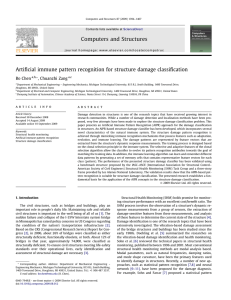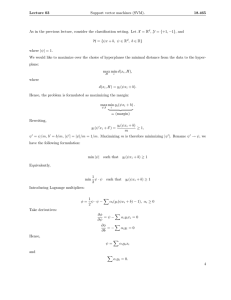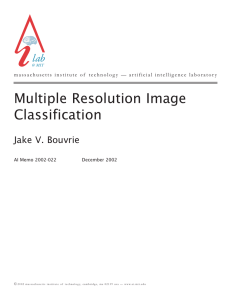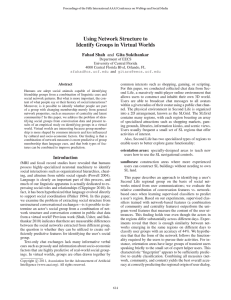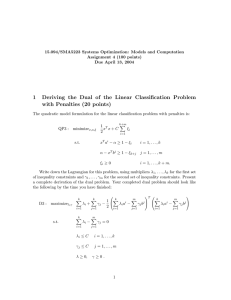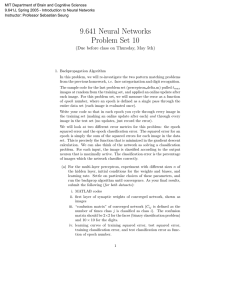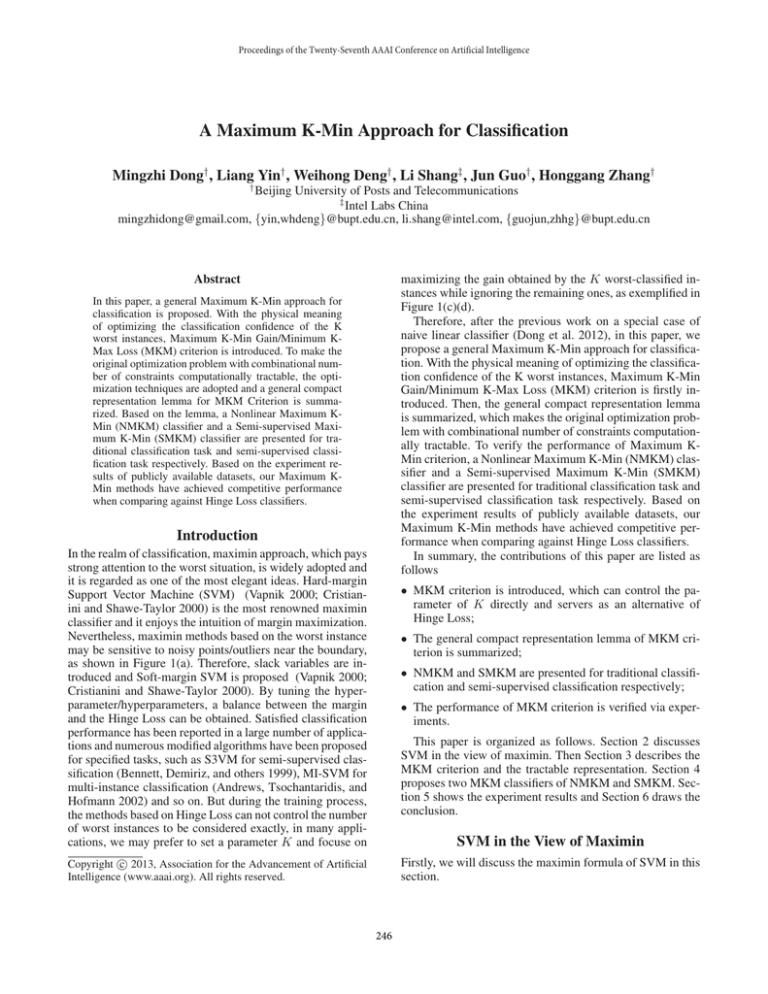
Proceedings of the Twenty-Seventh AAAI Conference on Artificial Intelligence
A Maximum K-Min Approach for Classification
Mingzhi Dong† , Liang Yin† , Weihong Deng† , Li Shang‡ , Jun Guo† , Honggang Zhang†
†
Beijing University of Posts and Telecommunications
‡
Intel Labs China
mingzhidong@gmail.com, {yin,whdeng}@bupt.edu.cn, li.shang@intel.com, {guojun,zhhg}@bupt.edu.cn
maximizing the gain obtained by the K worst-classified instances while ignoring the remaining ones, as exemplified in
Figure 1(c)(d).
Therefore, after the previous work on a special case of
naive linear classifier (Dong et al. 2012), in this paper, we
propose a general Maximum K-Min approach for classification. With the physical meaning of optimizing the classification confidence of the K worst instances, Maximum K-Min
Gain/Minimum K-Max Loss (MKM) criterion is firstly introduced. Then, the general compact representation lemma
is summarized, which makes the original optimization problem with combinational number of constraints computationally tractable. To verify the performance of Maximum KMin criterion, a Nonlinear Maximum K-Min (NMKM) classifier and a Semi-supervised Maximum K-Min (SMKM)
classifier are presented for traditional classification task and
semi-supervised classification task respectively. Based on
the experiment results of publicly available datasets, our
Maximum K-Min methods have achieved competitive performance when comparing against Hinge Loss classifiers.
In summary, the contributions of this paper are listed as
follows
Abstract
In this paper, a general Maximum K-Min approach for
classification is proposed. With the physical meaning
of optimizing the classification confidence of the K
worst instances, Maximum K-Min Gain/Minimum KMax Loss (MKM) criterion is introduced. To make the
original optimization problem with combinational number of constraints computationally tractable, the optimization techniques are adopted and a general compact
representation lemma for MKM Criterion is summarized. Based on the lemma, a Nonlinear Maximum KMin (NMKM) classifier and a Semi-supervised Maximum K-Min (SMKM) classifier are presented for traditional classification task and semi-supervised classification task respectively. Based on the experiment results of publicly available datasets, our Maximum KMin methods have achieved competitive performance
when comparing against Hinge Loss classifiers.
Introduction
In the realm of classification, maximin approach, which pays
strong attention to the worst situation, is widely adopted and
it is regarded as one of the most elegant ideas. Hard-margin
Support Vector Machine (SVM) (Vapnik 2000; Cristianini and Shawe-Taylor 2000) is the most renowned maximin
classifier and it enjoys the intuition of margin maximization.
Nevertheless, maximin methods based on the worst instance
may be sensitive to noisy points/outliers near the boundary,
as shown in Figure 1(a). Therefore, slack variables are introduced and Soft-margin SVM is proposed (Vapnik 2000;
Cristianini and Shawe-Taylor 2000). By tuning the hyperparameter/hyperparameters, a balance between the margin
and the Hinge Loss can be obtained. Satisfied classification
performance has been reported in a large number of applications and numerous modified algorithms have been proposed
for specified tasks, such as S3VM for semi-supervised classification (Bennett, Demiriz, and others 1999), MI-SVM for
multi-instance classification (Andrews, Tsochantaridis, and
Hofmann 2002) and so on. But during the training process,
the methods based on Hinge Loss can not control the number
of worst instances to be considered exactly, in many applications, we may prefer to set a parameter K and focuse on
• MKM criterion is introduced, which can control the parameter of K directly and servers as an alternative of
Hinge Loss;
• The general compact representation lemma of MKM criterion is summarized;
• NMKM and SMKM are presented for traditional classification and semi-supervised classification respectively;
• The performance of MKM criterion is verified via experiments.
This paper is organized as follows. Section 2 discusses
SVM in the view of maximin. Then Section 3 describes the
MKM criterion and the tractable representation. Section 4
proposes two MKM classifiers of NMKM and SMKM. Section 5 shows the experiment results and Section 6 draws the
conclusion.
SVM in the View of Maximin
c 2013, Association for the Advancement of Artificial
Copyright Intelligence (www.aaai.org). All rights reserved.
Firstly, we will discuss the maximin formula of SVM in this
section.
246
10
10
8
8
6
6
4
4
2
2
0
0
−2
−2
−4
−4
−6
−6
−8
−8
−10
−15
−10
−5
0
5
10
−10
−15
15
−10
(a) Maximin(Hard-margin SVM)
−5
0
5
10
15
10
15
(b) Maximum K-Min (K=2)
10
10
8
8
6
6
4
4
2
2
0
0
−2
−2
−4
−4
−6
−6
−8
−8
−10
−15
−10
−5
0
5
10
−10
−15
15
(c) Maximum K-Min (K=4)
−10
−5
0
5
(d) Maximum K-Min (K=N)
Figure 1: A comparison of Maximin Approach (Hard-Margin SVM) and linear Maximum K-Min Approach(Support Vectors/Worst K
Instances are marked ×). When selected as the support vectors, the outliers near the decision boundary have much influence in Maximin
approach, as shown in (a). In contrast, with proper chosen K, Maximum K-Min approach will be more robust, as shown in (c)(d).
Maximin Formula of Hard-Margin SVM
tries to find a hyperplane best classifying the worst instance/instances.
To solve Formula 3, by assigning a lower bound to the
numerator and minimizing the denominator, the following Quadratic Programming (QP) formula of SVM (Vapnik
2000; Cristianini and Shawe-Taylor 2000) can be obtained
In traditional binary classification, the task is to estimate the
parameters w of a classification function f according to a set
of training instances whose categories are known. Under linear assumption, the classification function can be expressed
as f (x, w) = wT x + b. Then, the category t of a new instance x will be determined as follows
f (x, w) ≥ 0 −→ t = 1;
f (x, w) < 0 −→ t = −1.
n = 1, . . . , N
(1)
w,b
n
tn f (xn , w)
},
w
n = 1, . . . , N.
s.t.
tn (wT xn + b) ≥ 1;
n = 1, . . . , N.
(4)
Different from the above formula, we can also assign an
upper bound to the denominator and maximize the numerator. Then the original objective function can be reformulated into the following Quadratically Constrained Linear
Programming (QCLP) formula
(2)
where fn = f (xn , w), xn indicates the nth training instances, tn indicates the corresponding label, N indicates
the number of training instances.
Hard-margin SVM defines margin as the smallest distance
between the decision boundary and any of the training instances. A set of parameters which maximizes the margin
will be obtained during the training process. The original
objective function of linear Hard margin SVM can be expressed as
max{min
wT w;
w,b
In linear separable case, there will exist w such that
gn = tn fn = tn f (xn , w) ≥ 0,
min
max
min{tn (wT xn + b);
s.t.
wT w ≤ 1;
n = 1, . . . , N.
w,b
n
(5)
In the following derivation of our methods, a similar reformulation strategy will be adopted.
Soft-Margin SVM with Hinge Loss
(3)
It is well known that hard-margin SVM cannot deal with
non-linearly separable problems efficiently. In Soft-margin
SVM (Vapnik 2000; Cristianini and Shawe-Taylor 2000), by
Therefore, it is obvious that Hard-margin SVM can be interpreted as a special case of maximin (Bishop 2006), which
247
introducing the slack variables ξn > 0 and the constraints,
an objective function making a balance between the Hinge
Loss and the margin is given
min
w,b,ξ
s.t.
C
N
ξn + 12 w2 ;
n=1
tn (wT xn
ξn ≥ 0,
+ b) + ξn ≥ 1;
n = 1, . . . , N.
Definition 1: MKM Criterion The parameters w of a
classifier is obtained via the minimization of K-Max Loss
ΘK (Dong et al. 2012)
w
(6)
max
a
n=1
an −
s.t.
1
2
N
N
n=1 m=1
N
n=1
0 ≤ an ≤ C,
min
w
s.t.
where
an am tn tm k(xn , xm );
an tn = 0;
K
n=1
θ[n] .
(9)
Therefore, according to the above definition, the MKM can
be expressed as the following optimization problem
With kernel k(xn , xm ), the corresponding Lagrange dual
optimization problem can be obtained
N
ΘK =
min
(7)
s;
ln1 + · · · + lnK ≤ s;
1 ≤ n1 ≤ · · · ≤ nK ≤ N.
(10)
i.e. minimize the maximum of all possible sums of K different elements of y. If f (x, w) is defined to be convex,
ln = −tn fn , n = 1, . . . , N is convex.
n = 1, . . . , N.
f (x) can be expressed in terms of Lagrange multipliers an
and the kernel function
N
an tn k(x, xn ) + b.
(8)
f (x) =
Tractable Representation
However, it’s prohibitive to solve an optimization problem
K
inequality constrains. We need to summarize a
with CN
compact formula with the optimization techniques (Boyd
and Vandenberghe 2004). Firstly, we introduce the following lemma.
n=1
MKM Criterion and Tractable Representation
Lemma 1 For a fixed integer K, the sum of K largest elements of a vector l, is equivalent to the optimal value of a
linear programming problem as follows,
As discussed above, hard-margin SVM solves maximin
problem. Soft-margin SVM enhances the robustness of maximin via the introduction of slack variables and it draws
a balance between the margin and the Hinge Loss by adjusting hyperparameter according to the training instances.
In the following section, we will introduce MKM Criterion
and adopt optimization techniques to obtain a computational
tractable representation of MKM Criterion.
max
z
s.t.
where
MKM Criterion
lT z;
0 ≤ zn ≤ 1;
n zn = K;
n = 1, . . . , N ;
z = (z1 , . . . , zN )T .
(11)
Proof According to the definition, θ[1] ≥ . . . θ[n] ≥ . . . θ[N ]
denote the elements of l sorted in decreasing order.
With a fixed integer K, the optimal value of max lT z under
the constraints is obviously θ[1] + . . . θ[K] , which is the same
as the sum of K largest elements of y, i.e. ΘK (y) = θ[1] +
. . . θ[K] .
Maximum K-Min Gain can be readily solved via Minimum
K-Max Loss. Since Minimum K-Max are more frequently
discussed in the realm of optimization, in the following sections, MKM Criterion will be discussed and solved via minimizing K-Max Loss.
According to Formula 2, gn = tn fn = tn f (xn , w)
represents the classification confidence of the nth training
instance xn ; gn ≥ 0 indicates the correct classification of
xn and the larger gn is, the more confident the classifier
outputs the classification result. Therefore, we can define
a vector g = (g1 , . . . , gN )T ∈ RN to represent a kind
of classification gain of all training instances. Then, l =
−g = (−g1 , . . . , −gN )T = (−t1 f1 , . . . , −tN fN )T ∈ RN
can be introduced to represent a kind of classification loss.
After that, by sorting ln in descent order, we can obtain
θ = (θ[1] , . . . , θ[N ] )T ∈ RN where θ[n] denotes the nth
largest element of l, i.e. the ith largest loss of the classifier.
Based on the above discussion,
K K-Max Loss of a classifier
can be defined as ΘK = n=1 θ[n] , with 1 ≤ K ≤ N and
it measures the sum loss of the worst K training instances
during classification. Therefore, the minimization of K-Max
Loss with respect to the parameters can result in a classifier
which performs best with regard to the worst K training
instances.
According to Lemma 1, we can obtain an equivalent representation of ΘK with 2N + 1 constraints. Nevertheless, l is
multiplied by z, this can be solved by deriving the dual of
Formula 11
Ks + n un ;
min
s,u
s.t.
where
s + u n ≥ ln ;
un ≥ 0;
n = 1, . . . , N ;
u = (u1 , . . . , uN )T .
(12)
According to the strong duality theory, the optimal value of
Formula 12 is equivalent to the optimal value of Formula 11.
To make the above conclusion more general, we introduce
the following Equivalent Representation Lemma.
Lemma 2 ΘK can be equivalently represented as follows
(1)In the objective Function:
min
248
ΘK .
(13)
is equivalent to
Ks +
min
s,u
s.t.
where
n
KNN (Cover and Hart 1967) in binary classification can
be regarded as a special case of the above assumption with
ai = 1, i = 1, . . . , N and s(x, xi ) of the following formula
1, if xi is the k-nearest neighbor of x.
s(x, xi ) =
0, else.
A test point x can be classified by KNN according to the
sign of f (x).
In Bayesian Linear Regression (Bishop 2006), the mean
of the predicated variable can be obtained according to the
following formula
N
k(x, xi )ti .
m(x) =
un ;
s + u n ≥ ln ;
un ≥ 0;
n = 1, . . . , N ;
u = (u1 , . . . , uN )T .
(14)
(2)In the constraints:
l satisfies ΘK ≤ α
(15)
is equivalent to
i=1
This form can also be considered as a special case of
assumption Equation 17, where s(x, x ) = k(x, x ) =
βφ(x)T SN φ(x ) is known as the equivalent kernel.
There exists s,
u which satisfy
Ks + un ≤ α;
n
s + un ≥ ln ;
un ≥ 0;
n = 1, . . . , N ;
u = (u1 , . . . , uN )T .
(16)
Nonlinear Maximum K-Min Classifier Under the assumption of Formula 17, the original optimization Formula
of NMKM is proposed as follows
β;
min
a,b,β
K−largest
ai s(xn , xi )ti + b tn ≤ βn ;
s.t.
Maximum K-Min Classifiers
In this section, we will adopt Lemma 2 to design Maximum
K-Min Classifiers.
i=1,...,n−1,n+1,...,N
aT a ≤ 1;
n = 1, . . . , N ;
a = (a1 , . . . , aN )T ;
β = (β1 , . . . , βN )T .
(19)
β indicates the
In the above optimization problem,
MKM Classifier for Traditional Classification
where
First, we will design a Nonlinear Maximum K-Min Classifier (NMKM) for traditional binary classification task.
Linear Representation Assumption To utilize kernel in
NMKM approach, we make the following linear representation assumption directly
f (x, a, b) =
N
ai s(x, xi )ti + b
K−largest
K-largest elements of vector β. The regularization of parameters a is performed via a similar way as Formula 5. We can
also add a l1 or l2 regularization term in the objective function, but in this way we have to deal with one more hyperparameter.
(17)
i=1
where s(x, xi ) denotes certain kind of similarity measurement between x and xi . Kernel function is certainly a good
choice. a = {a1 , . . . , aN } denotes the weight of training instances in the task of classification. Thus, under this assumption, the local evidence is weighted more strongly than distant evidence and different points also show different importance during classification. The prediction of x is made by
taking weighted linear combinations of the training set target
values, where the weight is the product of ai and s(x, xi ).
During the training process of NMKM, the similarity between xn and itself will not be considered. Therefore, the
term of s(xn , xn ) is deleted and we have the following fn
fn =
ai s(xn , xi )ti + b.
(18)
Tractable Formula of NMKM According to Lemma 2,
we can obtain a tractable representation for NMKM as follows
N
Ks + n=1 un ;
min
a,b,u,s
ai s(xn , xi )ti + b tn ≤ s + un ;
s.t.
i=1,...,n−1,n+1,...,N
where
aT a ≤ 1;
ui ≥ 0
n = 1, . . . , N ;
a = (a1 , . . . , aN )T ;
u = (u1 , . . . , uN )T .
(20)
K
+ 1 conThus the original optimization problem with CN
straints is reformulated into a convex problem with 2N + 1
constraints. As a Quadratically Constrained Linear Programming (QCLP) problem, standard convex optimization
methods, such as interior-point methods (Boyd and Vandenberghe 2004) (Wright 1997), can also be adopted to solve the
above problem efficiently and a global maximum solution is
guaranteed.
i=1,...,n−1,n+1,...,N
Different from Equation 8, there’s no constraint of ai in
our model assumption. Thus during the learning process, we
may obtain ai with negative value, which indicates that xi
may be mistakenly labeled. For a dataset carefully labeled
without mistakes, the constrains of ai ≥ 0 can be added as
prior knowledge manually.
249
In the above formula, K−largest {α; β} indicates the Klargest elements of a set γ which contains all elements of α
and β, i.e. γ = (αL+1 , . . . , αL+U , βL+1 , . . . , βL+U )T .
MKM Classifier for Semi-supervised Classification
Semi-supervised Classification and S3VM In practical
classification problems, since the labeling process is always
expensive and laborious, semi-supervised Learning is proposed and tries to improve the classification performance
with unlabeled training sets (Chapelle et al. 2006). Therefore, semi-supervised classifiers make use of both labeled
and unlabeled data for training and fall between unsupervised classifier (without any labeled training data) and supervised classifier (with completely labeled training data).
As illustrated in (Bennett, Demiriz, and others 1999),
Semi-Supervised SVM(S3VM) is a natural extension of
SVM in semi-supervised problems and the objective function of S3VM can be written as
L
L+U
C1
ηi + C 2
(ξi + zj ) + wT w;
min
w,b,η,ξ,z,d
i=1
Tractable Formula of SMKM According to Lemma 2,
we can obtain a tractable representation for SMKM as follows
min
w,b,η,d,u,s
j=L+1
yi (wT xi + b) + ηi ≥ 1;
T
w xj + b + ξj + M (1 − dj ) ≥ 1;
−(wT xj + b) + zj + M dj ≥ 1;
ηi ≥ 0; ξj ≥ 0; zj ≥ 0;
where
M > 0 is a sufficiently large constant;
i = 1, . . . , L; j = L + 1, . . . , L + U ;
η = (η1 , . . . , ηL )T ;
ξ = (ξL+1 , . . . , ξL+U )T ;
z = (zL+1 , . . . , zL+U )T ;
d = (dL+1 , . . . , dL+U )T ;
dj ∈ {0, 1}.
(21)
In the above formula, L indicates the size of labeled training
set; U indicates the size of unlabeled training set; dj is a binary variable which indicates the predicated category of the
L
unlabeled training instances; i=1 ηi measures the Hinge
L+U
Loss of the labeled training instances and j=L+1 (ξi + zj )
measures the Hinge Loss of the unlabeled training instances.
Since the optimization problem has both binary variables
and continuous variables, it is a Mixed-Integer Quadratic
Programming (MIQP) problem and the globally optimal solution can be solved via commercial solvers, such as Gurobi
(Optimization 2012) and Cplex (CPLEX 2009).
where
i=1
2U
n=1
un );
T
Experiment
Traditional Classification Experiment
In the experiment of traditional classification , NMKM with
Radical Basis Function (RBF) kernel matrix is compared
to SVM with RBF kernel and L2-regularized Logistic Regression (LR). NMKM is implemented using cvx toolbox1
(CVX Research ; Grant and Boyd 2008) in matlab environment with the solver of SeDuMi (Sturm 1999). LR is implemented using libliner toolbox2 and kernel SVM is implemented using libsvm toolbox3 (Chang and Lin 2011).
Ten publicly available binary classification datasets are
adopted in the experiment. The detailed features are shown
in Table 1. The parameters of NMKM and SVM are chosen
via 10 fold cross-validation during the training stage. For
NMKM, 21 values for parameter K ranging from 2 to N are
tested, where N indicates the number of training instances.
31 values for parameters C ranging from 2−20 to 220 are
tested for SVM. The step size of C in the log searching domain of [−20, −10) or (10, 20] is 2 and [−10, 10] is 1.
As shown in Table 2, among 10 different datasets, NMKM
achieves best accuracy in 6 datasets. SVM performs best in
2 datesets and LR shows best performance in 2 datasets.
Among all datasets which SVM or LR performes better
than NMKM, NMKM performs slightly weaker than SVM
or LR. While for datasets which NMKM gains better performance, the accuracy of NMKM may be much higher
than MSVM and LR. The accuracy gap of SVM in dataset
Semi-supervised Maximum K-Min Classifier We will
adopt MKM Criterion to measure the loss of unlabeled training set and we can obtain the following formula
L
ηi + C
{α; β};
min
s.t.
i=1
ηi + C(Ks +
yi (w xi + b) + ηi ≥ 1;
wT xj + b + M (1 − dj ) − s − ut ≤ 0;
−(wT xj + b) + M dj − s − ut+U ≤ 0;
wT w ≤ 1; η ≥ 0; u ≥ 0;
where
M > 0 is a sufficiently large constant;
i = 1, . . . , L; t = 1, . . . , U ;
j = L + 1, . . . , L + U ;
η = (η1 , . . . , ηL )T ;
u = (u1 , . . . , u2U )T ;
d = (dL+1 , . . . , dL+U )T ;
dj ∈ {0, 1}.
(23)
The above formula is a Mixed-Integer Quadratically Constrained Programming (MIQCP) problem and the globally
optimal solution can be obtained via optimization solvers,
such as Gurobi (Optimization 2012) and Cplex (CPLEX
2009).
s.t.
s.t.
w,b,η,d,α,β
L
K−largest
yi (wT xi + b) + ηi ≥ 1;
T
w xj + b + M (1 − dj ) ≤ αj ;
−(wT xj + b) + M dj ≤ βj ;
wT w ≤ 1; ηi ≥ 0;
M > 0 is a sufficiently large constant;
i = 1, . . . , L; j = L + 1, . . . , L + U ;
η = (η1 , . . . , ηL )T ;
α = (αL+1 , . . . , αL+U )T ;
β = (βL+1 , . . . , βL+U )T ;
d = (dL+1 , . . . , dL+U )T ;
dj ∈ {0, 1}.
(22)
1
http://cvxr.com/
www.csie.ntu.edu.tw/ cjlin/liblinear
3
www.csie.ntu.edu.tw/ cjlin/libsvm
2
250
datasets
australian
breast-cancer
colon-cancer
diabetes
fourclass
german.numer
heart
ionosphere
liver-disorders
splice
Table 1: Detailed Features of the Binary Classification Datasets in NMKM Experiment
sources
features instances(training) instances(testing) instances(total)
Statlog / Australian
14
414
276
690
UCI / Wisconsin Breast Cancer
10
410
273
683
paper (Alon et al. 1999)
62
37
25
62
UCI / Pima Indians Diabetes
8
460
308
768
paper (Ho and Kleinberg 1996)
2
517
345
862
Statlog / German
24
600
400
1000
Statlog / Heart
13
162
108
270
UCI / Ionosphere
34
210
141
351
UCI / Liver-disorders
6
207
138
345
Delve / splice
60
1,000
2,175
3,175
Figure 2: Experiment Results of SMKM
’Pima’. Therefore, SMKM has obtained competitive performance when comparing against S3VM in semi-supervised
experiment.
Conclusion
In this paper, a general Maximum K-Min approach for classification is proposed. By reformulating the original objective function into a compact representation, the optimization of MKM Criterion becomes tractable. To verify the performance of MKM methods, a Nonlinear Maximum K-Min
(NMKM) classifier and a Semi-supervised Maximum KMin (SMKM) classifier are presented for traditional classification task and semi-supervised classification task respectively. As shown in the experiments, the classification performance of Maximum K-Min classifiers is competitive with
Hinge Loss classifiers.
liver and LR in dataset fourclass from NMKM is 8.86%
and 27.85% respectively. Thus we can conclude, in traditional classification experiment, compared with SVM and
LR, NMKM has obtained competitive classification performance.
Semi-supervised Classification Experiment
In the experiment of semi-supervised classification , SMKM
is compared with S3VM. Both SMKM and S3VM are implemented using cvx toolbox (CVX Research ; Grant and
Boyd 2008) in matlab environment with the solver of Gurobi
(Optimization 2012). Three publicly available UCI datasets
of ’Cancer’, ’Heart’ and ’Pima’ are selected for comparison. All datasets are randomly splitted into labeled training set (50 instances), unlabeled training set (50 instances)
and the testing set (all other instances). The hyperparameters of NMKM (C, K) and SVM (C1 , C2 ) are chosen via
10 fold cross-validation during the training stage. 11 values
for C, C1 , C2 ranging from 2−5 to 25 are tested. 10 values
for K ranging from 1 to 20 are tested. As shown in Figure 2, SMKM performs better in the datasets of ’Cancer’
and ’Heart’, while S3VM performs better in the dataset of
Acknowledge
We would like to thank the anonymous reviewers for their
insight and constructive comments, which helped improve
the presentation of this paper. Meanwhile, this work was
partially supported by National Natural Science Foundation
of China under Grant No.61005025, 61002051, 61273217,
61175011 and 61171193, the 111 project under Grant
No.B08004 and the Fundamental Research Funds for the
Central Universities.
251
References
Alon, U.; Barkai, N.; Notterman, D. A.; Gish, K. W.; Ybarra,
S.; Mack, D.; and Levine, A. J. 1999. Broad patterns of
gene expression revealed by clustering analysis of tumor
and normal colon tissues probed by oligonucleotide arrays.
Proceedings of The National Academy of Sciences 96:6745–
6750.
Andrews, S.; Tsochantaridis, I.; and Hofmann, T. 2002. Support vector machines for multiple-instance learning. Advances in neural information processing systems 15:561–
568.
Bennett, K.; Demiriz, A.; et al. 1999. Semi-supervised support vector machines. Advances in Neural Information processing systems 368–374.
Bishop, C. 2006. Pattern recognition and machine learning.
Springer.
Boyd, S., and Vandenberghe, L. 2004. Convex optimization.
Cambridge Univ Press.
Chang, C.-C., and Lin, C.-J. 2011. Libsvm: a library for
support vector machines. ACM Transactions on Intelligent
Systems and Technology (TIST) 2(3):27.
Chapelle, O.; Schölkopf, B.; Zien, A.; et al. 2006. Semisupervised learning, volume 2. MIT press Cambridge.
Cover, T., and Hart, P. 1967. Nearest neighbor pattern
classification. Information Theory, IEEE Transactions on
13(1):21–27.
CPLEX, I. I. 2009. V12. 1: Users manual for cplex. International Business Machines Corporation 46(53):157.
Cristianini, N., and Shawe-Taylor, J. 2000. An introduction
to support vector machines and other kernel-based learning
methods. Cambridge university press.
CVX Research, I. CVX: Matlab software for disciplined
convex programming, version 2.0 beta.
Dong, M.; Yin, L.; Deng, W.; Wang, Q.; Yuan, C.; Guo, J.;
Shang, L.; and Ma, L. 2012. A linear max k-min classifier. In Pattern Recognition (ICPR), 2012 21st International
Conference on, 2967–2971. IEEE.
Grant, M., and Boyd, S. 2008. Graph implementations for
nonsmooth convex programs. In Blondel, V.; Boyd, S.; and
Kimura, H., eds., Recent Advances in Learning and Control, Lecture Notes in Control and Information Sciences.
Springer-Verlag Limited. 95–110.
Ho, T. K., and Kleinberg, E. M. 1996. Building projectable
classifiers of arbitrary complexity. In International Conference on Pattern Recognition, volume 2.
Optimization, G. 2012. Gurobi optimizer reference manual.
URL: http://www. gurobi. com.
Sturm, J. F. 1999. Using sedumi 1.02, a matlab toolbox for
optimization over symmetric cones. Optimization methods
and software 11(1-4):625–653.
Vapnik, V. 2000. The nature of statistical learning theory.
Springer-Verlag New York Inc.
Wright, S. 1997. Primal-dual interior-point methods, volume 54. Society for Industrial Mathematics.
252

